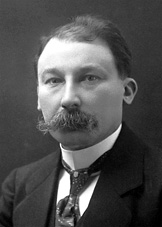<Back to Index>
- Chemist François Auguste Victor Grignard, 1871
- Painter Lorenzo Lippi, 1606
- Left Wing Militant Andreas Bernd Baader, 1943
PAGE SPONSOR

François Auguste Victor Grignard (May 6, 1871 in Cherbourg - December 13, 1935 in Lyon) was a Nobel Prize winning French chemist.
Grignard
was the son of a sail maker. After studying mathematics at Lyon he
transferred to chemistry and discovered the synthetic reaction bearing
his name (the Grignard reaction) in 1900. He became a professor at the University of Nancy in 1910 and was awarded the Nobel Prize in Chemistry in 1912. During World War I he was studying chemical warfare agents, particularly the manufacture of phosgene and the detection of mustard gas. His counterpart on the German side was another Nobel Prize winning Chemist, Fritz Haber. Grignard
is most noted for devising a new method for generating carbon-carbon
bonds using magnesium to couple ketones and alkyl halides. This reaction is valuable in organic synthesis. It occurs in two steps: The
Grignard reaction is an important means of preparing organic compounds
from smaller precursor molecules. For this work, Grignard was awarded
the Nobel Prize in Chemistry in 1912 jointly with fellow Frenchman Paul Sabatier.